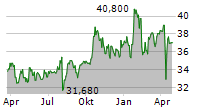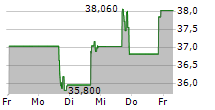NORTHAMPTON, MA / ACCESS Newswire / June 5, 2025 / Xiaoyu Gu| Managing Director-AB CarVal
Deanna Leighton, CFA| Lead Portfolio Manager-Insurance Portfolio Management
Gerry Anderson| Insurance Solutions Specialist
Investment in clean energy infrastructure may tick a lot of boxes for life insurers.
Matching assets to long-term liabilities without compromising on return potential can be a challenge for insurers with long-duration liabilities. Investment in renewable energy infrastructure may provide a clever way to tackle that challenge.
The opportunity set in this arena is expansive. Last year, the world invested almost twice as much in clean energy as it did in fossil fuels, according to the International Energy Agency. Financing is increasingly coming from private capital providers who are able to structure assets that can meet life insurers' unique needs.
These assets can come with investment-grade ratings from the major ratings agencies, which may increase relative attractiveness on a capital-adjusted yield and spread basis. And maturities in the 20-year range make them a good match for insurers with long-term liabilities.
Other potential benefits include:
High Return Potential: Assets typically sit on the lowest rung of the investment-grade ratings ladder, which usually means larger spreads and enhanced return potential over similar quality long-term assets, including utility bonds and publicly traded government and corporate debt. Illiquidity premiums also enhance return potential.
Diversification Benefits: Because these assets tend to have relatively low correlations with similar duration assets, they may offer an effective way to diversify insurers' portfolios.
Capital Efficiency: Certain renewable energy infrastructure-particularly in Europe-may warrant a substantial reduction in capital requirements.
Muted Default History: Defaults on private infrastructure financing have been consistently lower than those on comparable public corporate bonds issued by nonfinancial companies (Display).
Traditionally, banks have provided a healthy share of the financing for renewable energy infrastructure. But projects have grown larger as bank balance sheets have become more constrained, with private credit assuming a larger role.
That's good news for insurers, because private lenders can pool projects into investment portfolios that may help reduce single-asset risk. For example, a pooled portfolio might include community solar projects across multiple states, all contracted with utilities or other investment-grade offtakers.
Private credit's flexibility to structure assets in ways that meet insurers' longer time horizons has also created a steadier source of capital for developers, who would otherwise be forced to rely on shorter-term bank financing.
US Offers a Broader Opportunity Set
Today, we see the most attractive opportunities in the US-for both US and European insurers. Clean energy is the fastest growing-and least expensive-electricity source in the country, and the market's sheer size opens up broader investment options.
Renewable power is even more entrenched in Europe's energy ecosystem, with solar and wind having overtaken fossil fuels, according to Ember, a think tank. But for now, few assets come with similarly insurance-friendly structures and investment-grade credit ratings.
The Tale of Tariffs: Assessing the Risks
US tariffs on a range of imports will affect energy infrastructure opportunities, particularly for projects being planned and waiting on imported equipment. But while China remains the largest single producer of solar panels, the widening of supply chains beyond China in recent years has blunted the impact of tariffs on new construction.
More importantly, the low cost of solar energy in recent years has prompted developers to fast-track projects, creating a healthy inventory of operating plants not subject to tariffs. These are the projects that fit most comfortably into insurance portfolios. They come with investment-grade ratings and can be structured as long-term debt that helps insurers match assets to liabilities.
Overall, we expect little effect on projects expected to come online in 2025, since equipment should already be in the country. Delays may pick up in 2026 from supply chain challenges. Potential changes to the Inflation Reduction Act (IRA) that reduce or eliminate tax credits may also slow momentum.
But we see these as short-term hiccups. Global energy demand is surging. In 2024, it rose by 2.2%, according to the IEA, a significant jump from the 1.3% annual average between 2013 and 2023. This adds up to trillions of dollars of investment per year on an annualized basis. Meeting that demand will require a healthy dose of renewable energy infrastructure, in our view.
Weighing the Regulatory Considerations
When assessing the opportunity, non-US insurers will have to consider the higher cost of currency hedges when matching US-dollar assets against non-dollar liabilities. This will require reviewing the costs of FX forwards and over-the-counter cross country hedges and how currency volatility will affect those costs.
Regulatory considerations will vary across regions, too. In Europe, insurers should carefully review the rating methodology used-whether internal or external. Also important: determining whether the underlying asset can be classed as "qualifying infrastructure," which can reduce capital requirements. Insurers that apply the matching adjustment mechanism will need to review any cash flow prepayment features to ensure compliance with all Matching Adjustment eligibility requirements.
For US-based insurers, most of the opportunity set is rated BBB- and carries a NAIC rating of 2.C, and may be considered as a component of private placement allocations.
Overall, though, we think these assets offer insurers with long liabilities an appealing opportunity to enhance returns on regulatory capital and diversification while reducing the risk of default. Tariffs have little impact on operating portfolios that are a good fit for insurance capital, and demand for power remains strong. We don't expect that to change.
The views expressed herein do not constitute research, investment advice or trade recommendations, and do not necessarily represent the views of all AB portfolio-management teams, and are subject to change over time.
Learn more about AB's approach to responsibility here.

View additional multimedia and more ESG storytelling from AllianceBernstein on 3blmedia.com.
Contact Info:
Spokesperson: AllianceBernstein
Website: https://www.3blmedia.com/profiles/alliancebernstein
Email: info@3blmedia.com
SOURCE: AllianceBernstein
View the original press release on ACCESS Newswire:
https://www.accessnewswire.com/newsroom/en/banking-and-financial-services/alliancebernstein-renewable-energy-and-insurers-tailor-made-1035938



